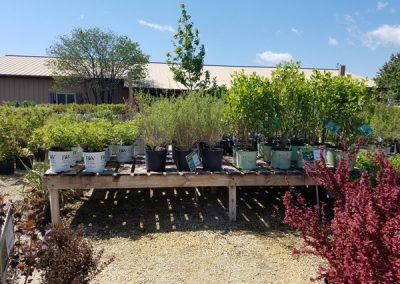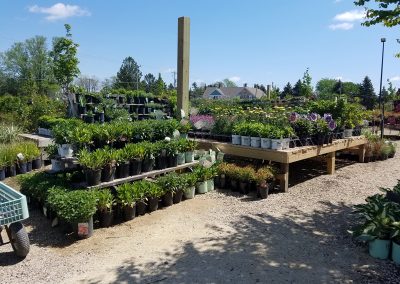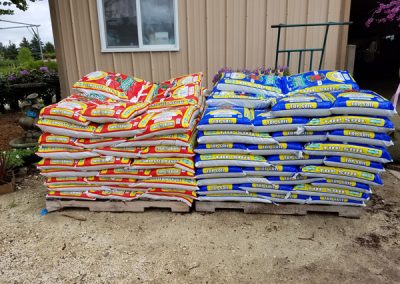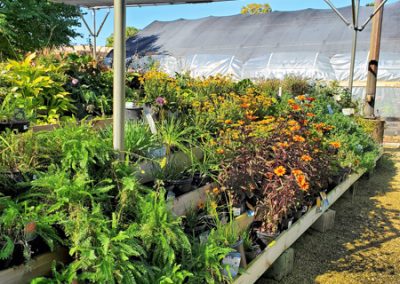With so many new varieties of plants out there, it’s hard not to impulse buy. However, it’s important to remember that some plants will give short-term color while others will add interesting appeal throughout the season. Take the time to research a prospect before making that purchase. Not all areas of your yard will be able to accommodate the plants that you may want. As silly as it may seem, on the next sunny day, take note of how much sun each area of your property receives.
Another thing to consider is the amount of wind exposure. Thus, doing a little research now and knowing beforehand can save you money and headaches down the road.
Don’t have that artistic skill? Stop in at Heritage Hill Nursery Inc. and see what our design team can do for you.
Perennials
Plants purchased at Heritage Hill Nursery, Inc. can stay in the containers they are purchased in. However, it’s important to water each pot thoroughly until the water visibly runs from the bottom; repeat this step every day until planted.
When ready to plant, use a 50/50 mixture of existing soil amended with a good planting soil (HHN sells planting soil by the bag). Hold off fertilizing for a year because they typically will have already been fertilized. Existing perennials, however, can benefit from either slow-release or liquid or organic fertilizers (all of which can be found at HHN). Once the plant is in the ground, you will need to water daily. Watering in the morning helps prevent wilting in the afternoon and allows the plant to thoroughly dry before nightfall. Sometimes it may be necessary to water twice a day if it’s really hot outside. Moisture probes are inexpensive and usually accurate ways to check when watering is needed.
- Bring out the peony cages and other plant supports and position them around the plants that will become top-heavy.
- Guiding new stems into the squares is easier than trying to carefully squeeze big flower heads into them later.
- Newly purchased perennials are usually safe to plant this month. Although, if the temps have been unseasonably low, wait another week.
- Place the pots outside during the day and bring them into the garage or into another protective environment at night.
Shrubs
Sprinkle a slow-release fertilizer (Heritage Hill Nursery, Inc. offers a vast selection of organic and regular fertilizer) around the base of the plant. Proactive measures against damaging insects and fungus should be taken early in the month before a problem arises. A brand that has worked well at the nursery is called, Bonide Systemic Insect Control and Bonide Infuse Systemic Disease Control.
Both of these products are liquid concentrate that can be safely mixed together and used on a wide range of plants. Since these products are both a systemic, the liquid is absorbed into the plant, so you can water plants freely without washing off the product.
Trees
Hold off on fertilizing trees that were purchased at Heritage Hill Nursery, Inc. last season as they were treated with a two-year slow-release fertilizer. If you are going to fertilize established trees, we recommend using Nutri-Pak (3 yr. slow release) as its safer for the environment, easy to use, and cost-efficient; it can be found at HHN.
Be on the lookout for tent caterpillars later this month. Not only are the large, pulsating masses unsightly, but these insects can also do damage to new foliage.
Before the caterpillars emerge, either uses a systemic insecticide spray, or you can prune the tent out of the tree and submerge it into a bucket of soapy water. Heritage Hill Nursery, Inc. used Bonide Systemic Insect Control because it absorbs into the plant and won’t wash off.
Lawns
Take proactive measures against crab grass towards the end of April/early May by applying a pre-emergent herbicide. However, new grass seedlings will also be killed. Due to this, it’s extremely important to not apply a pre-emergent now if you’re planning on seeding your lawn later in spring.
When the ground is dry, rake out or thatch any dead grass. Mowing shouldn’t begin until the grass reaches at least 2.5”, better if the grass reaches 3-3.5.” Furthermore, longer grass results in deeper root systems that have a better chance at warding off disease.
To achieve an even healthier lawn, first mow by cutting left to right. When it’s that time to mow again, now mow the lawn up and down in rows. Keep using this rotation throughout the season as it will help prevent unwanted wear patterns from developing.







